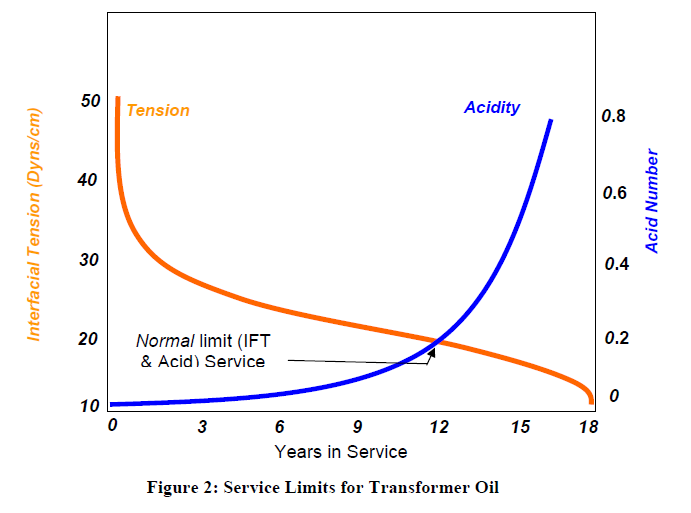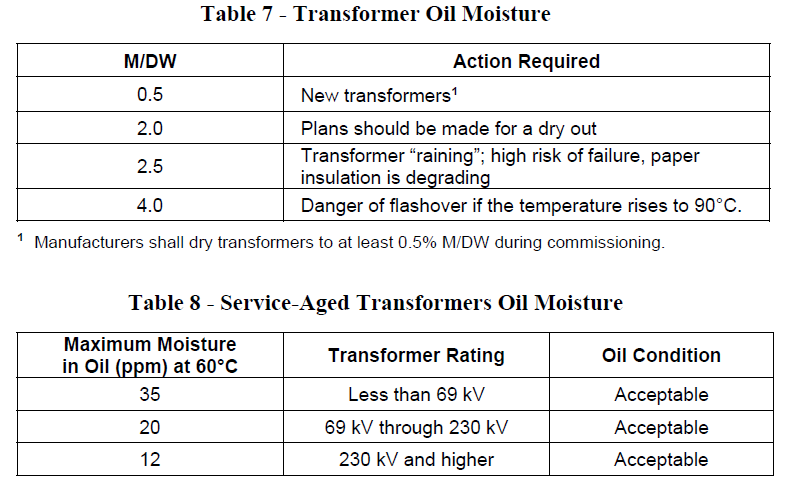Oil Physical and Chemical Tests – Power Transformer Diagnostics
When sending oil samples to a laboratory for DGA, one should also specify other tests that reveal oil quality.
Dielectric Strength
This test measures the voltage at which the oil electrically breaks down. The test gives an indication of the amount of contaminants (water and oxidation particles) in the oil. DGA laboratories typically use ASTM D-1816.

If a dielectric strength test falls below these numbers, the oil should be replaced.
Commentary Note:
{Final decisions shall not be based on one test result, or on one type of test; rather, several DGA tests and trends review shall be done before making any decision.
The dielectric strength test is not extremely valuable; moisture in combination with oxygen and heat destroy cellulose insulation long before the dielectric strength of the oil has indicated anything is going wrong. The dielectric strength test also reveals nothing about acids and sludge. The tests explained below are much more important in that regard.}
Interfacial Tension (IFT)
ASTM D-971-91, Standard Test Method for Interfacial Tension of Oil Against Water by the Ring Method, is used by DGA laboratories to determine the interfacial tension between the oil sample and distilled water. The oil sample is placed in a beaker of distilled water at a temperature of 25ºC. The oil will float because its specific gravity is less than that of water. There should be a distinct line between the two liquids. The IFT number is the amount of force (dynes) required to pull a small wire ring upward a distance of 1 cm through the
water/oil interface. A dyne is a very small unit of force equal to 0.000002247 pound. Clean oil will make a very distinct line on top of the water and give an IFT number of 40 to 50 dynes/cm of travel to the wire ring.
As oil ages, it is contaminated by tiny particles (oxidation products) of the oil and paper insulation. Particles on top of the water extend across the water/oil interface line which weakens the surface tension between the two liquids.
Particles in oil weaken interfacial tension and lower the IFT number. IFT and acid number (see below) together are an excellent indication of oil condition.
Figure 2 shows the relationship between acid number, the IFT, and years-inservice. The curve shows the normal service limits for both the IFT and the acid number.
Acid Number
Acid number is the amount of potassium hydroxide (KOH) in milligrams (mg) that it takes to neutralize the acid in 1 gram (gm) of transformer oil. The higher the acid number, the more acid is in the oil. New transformer oils contain practically no acid. The acids attack metals inside the tank and form soaps (more sludge). Acid also attacks cellulose and accelerates insulation degradation.
Furans
Furans are a family of organic compounds which are formed by degradation of paper insulation. Overheating, oxidation, acids, and decay caused by high moisture with oxygen accelerate the destruction of insulation and form furanic compounds. As with dissolved gases, increases in furans between DGA tests are important. When furans become greater than 250 parts per billion (ppb), the oil should be changed; paper insulation is being deteriorated and transformer life reduced at a high rate. Look at the IFT and acid number in conjunction with furans. Furanic content in the oil is especially helpful in estimating remaining life in the paper insulation, particularly if several prior tests can be compared
and trends established.
Oxygen (O2)
O2 must be watched closely in DGA tests. Many references suggest that above 2,000 ppm, oxygen in transformer oil greatly accelerates paper deterioration. This becomes even more critical with moisture above safe levels. Under the same temperature conditions, cellulose insulation in low oxygen oil will last 10 times longer than insulation in high oxygen oil. It is recommended that if oxygen reaches 10,000 ppm in the DGA, the oil should be de-gassed and new oxygen inhibitor installed. High atmospheric gases (O2 and nitrogen N2) normally mean that a leak has developed in a bladder or in the conservator. If there is no conservator and pressurized nitrogen is on top of oil, expect to see high nitrogen but not high oxygen. Oxygen comes only from leaks and from deteriorating insulation.
Oxygen inhibitor is key to extending the life of transformers. The inhibitor currently used is Ditertiary Butyl Paracresol (DBPC). This works similar to a sacrificial anode in grounding circuits; oxygen attacks the inhibitor instead of the cellulose insulation. As this occurs and the transformer ages, the inhibitor is used up and needs to be replaced. Replacement of the inhibitor generally requires that the oil also be treated. The ideal amount of DBPC is 0.3% by total weight of the oil, which is given on the transformer nameplate.
Oil Power Factor
Power factor indicates the dielectric loss (leakage current associated with watts loss) of the oil. This test can be performed by DGA laboratories. It may also be done by Doble testing in the field. A high power factor indicates deterioration and/or contamination from byproducts such as water, carbon, or other conducting particles, including metal soaps caused by acids attacking transformer metals, and products of oxidation. DGA labs normally test oil power factor at 25ºC and 100ºC.

Transformer Oil Moisture
Moisture, especially in the presence of oxygen, is extremely hazardous to transformer insulation. Recent EPRI studies show that oxygen above 2,000 ppm dissolved in transformer oil is extremely destructive. Each DGA and Doble test result should be examined carefully to see if water content is increasing and to determine the moisture by dry weight, which is percentage of moisture weight of water in paper insulation based on dry weight of paper given on transformer nameplate (M/DW). Each time the moisture is doubled in a transformer, the life of the insulation is cut by one-half. The life of the transformer is the life of the paper, and the life of the paper is extended by keeping out moisture and oxygen.
The use of absolute values for water does not always guarantee safe conditions, and the percent by dry weight should be determined. For example, in a transformer having 10,000 pounds of paper insulation, this means that 10,000 x 0.005 = 50 pounds of water (about 6 gallons) is in the paper.
Water is distributed equally through a new transformer, but when the transformer is energized, water begins to migrate to the coolest part of the transformer and the site of the greatest electrical stress. This location is normally the insulation in the lower one-third of the winding. The water will distribute itself unequally, with much more water being in the paper than in the oil. The paper will even partially dry the oil by absorbing water from the oil. Temperature is a vital factor in how the water distributes itself between the oil and paper; see table 9 below for comparison. The ppm of water in oil shown in the DGA is only a very small part of the water in the transformer.
The table above shows the tremendous attraction that paper insulation has for water and how the water changes in the paper with temperature. It is important when an oil sample is taken that the oil temperature from the top oil temperature gauge be recorded.




